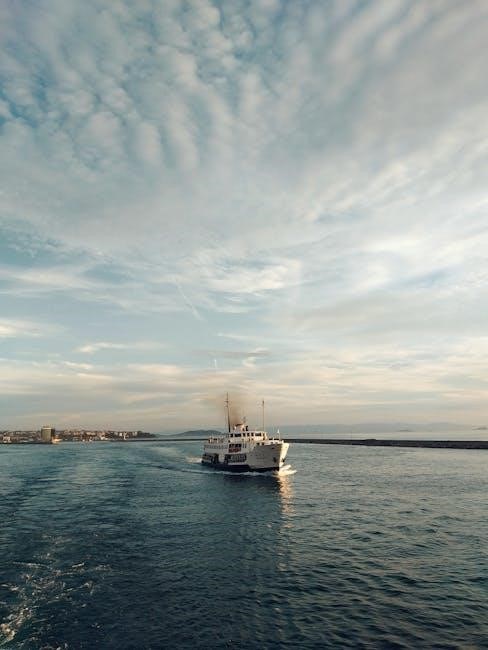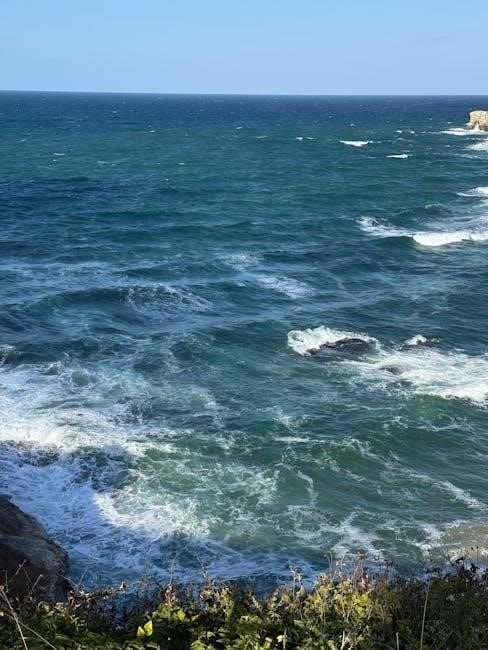Converting ocean data into PDF format ensures efficient data management, accessibility, and professional presentation. This guide explores methods, tools, and applications for seamless ocean to PDF conversion, emphasizing accuracy and security.
Overview of Ocean Data and PDF Format
Ocean data encompasses various types of information collected from marine environments, such as environmental metrics, biological surveys, and geological studies. PDF (Portable Document Format) is a universal file format ideal for preserving data integrity and layout. Converting ocean data to PDF ensures that complex datasets, images, and reports are easily shareable, accessible, and professionally formatted, making it a reliable choice for marine research, reporting, and archiving.
Importance of Converting Ocean Data to PDF
Converting ocean data to PDF ensures data integrity, accessibility, and professional presentation. PDFs are universally compatible, making them ideal for sharing research, reports, and images across platforms. This format preserves complex layouts and supports encryption for security. It also enables easy archiving and retrieval of marine data, fostering collaboration and compliance with industry standards. PDF conversion is essential for maintaining accuracy and efficiency in marine science and environmental monitoring.

Methods of Ocean to PDF Conversion
Convert ocean data to PDF using online tools, desktop apps, or programming solutions. These methods ensure efficient, accurate, and secure conversion, catering to various user needs and preferences.
Manual Conversion Techniques
Manual conversion involves copying ocean data into a document editor and saving it as a PDF. This method allows for precise control over formatting and content. Users can paste data into word processors like Microsoft Word or Google Docs, adjust layouts, and export as PDF. While time-consuming, manual techniques ensure data accuracy and customization, making them ideal for small-scale conversions or specific formatting needs.
Automated Conversion Tools
Automated tools streamline ocean to PDF conversion, offering speed and efficiency. Online services like iLovePDF and Docpose enable quick conversion of ocean data, supporting formats like DOC, Excel, and images. These tools provide features such as merging, splitting, and compressing files, ensuring high-quality PDF outputs. They are user-friendly, secure, and accessible online, making them ideal for users seeking hassle-free conversions without software installations.
Programming Solutions for Ocean to PDF
Programming solutions offer tailored approaches for ocean to PDF conversion. Libraries like iText (Java) and PyPDF2 (Python) enable developers to create custom scripts for converting ocean data into PDFs. These tools support data formatting, image embedding, and metadata management, ensuring precise control over the output. They are ideal for integrating PDF generation into larger applications, providing scalability and flexibility for complex data conversion needs while maintaining data integrity.
Tools and Software for Ocean to PDF
Utilize online tools like iLovePDF and Docpose for seamless ocean to PDF conversion. Desktop applications and mobile apps also offer efficient solutions for converting ocean data into professional PDFs.
Online Tools for Ocean to PDF Conversion
Online tools like iLovePDF and Docpose offer free, fast, and secure solutions for converting ocean data to PDF. These platforms support multiple file formats, enabling users to merge, split, and compress PDFs effortlessly. They also provide features like image-to-PDF conversion and document optimization, making them ideal for marine professionals and researchers. With user-friendly interfaces, these tools ensure high-quality PDF output while maintaining data integrity and security.
Desktop Applications for PDF Conversion
Desktop applications like Adobe Acrobat and specialized tools offer robust solutions for converting ocean data to PDF. These programs provide advanced features such as batch processing, data integrity preservation, and encryption for sensitive information. They support various input formats, ensuring seamless conversion of marine reports, images, and datasets. With offline functionality, desktop apps are ideal for professionals requiring reliable, high-quality PDF output without internet dependency.
Mobile Apps for Ocean to PDF
Mobile apps like Docpose and PDF Converter enable quick ocean data to PDF conversion on-the-go. These apps support image-to-PDF, document scanning, and cloud sharing, making them ideal for fieldwork. With features like encryption and secure conversion, they ensure data protection. Mobile apps are perfect for professionals needing to convert marine reports or images into PDF format efficiently, without compromising on quality or security.

Security and Data Integrity in Ocean to PDF
Ensuring data accuracy and protection during ocean to PDF conversion is crucial. Advanced encryption and secure protocols safeguard sensitive marine data, maintaining integrity and preventing unauthorized access.
Ensuring Data Accuracy During Conversion
Accurate conversion of ocean data to PDF is vital for maintaining data integrity. Using reliable tools like iLovePDF or Docpose ensures that formatting, charts, and tables remain intact. Advanced features such as batch processing and error checking further enhance precision, preventing data loss or misrepresentation. This ensures that the final PDF is a true representation of the original ocean data, critical for professional and secure outcomes.
File Size Optimization for PDF
Optimizing PDF file size is crucial for efficient sharing and storage. Tools like iLovePDF and Docpose offer compression features, reducing file size without compromising quality. By converting images to lower resolutions and removing unnecessary data, users can create lightweight PDFs while preserving essential information. This ensures faster uploads, downloads, and accessibility, making ocean data more manageable and convenient for various applications.
Security Measures for Sensitive Ocean Data
Protecting sensitive ocean data during PDF conversion is paramount. Use encryption and secure tools like iLovePDF or Docpose to ensure data privacy. Implement access controls and password protection for PDFs to prevent unauthorized access. Always verify the security features of conversion tools and comply with data privacy laws to safeguard your information throughout the process.
Applications of Ocean to PDF Conversion
Ocean to PDF conversion is vital in marine biology, environmental monitoring, education, and industrial applications, enabling efficient data sharing and professional presentation across various fields.
Marine Biology and Research
In marine biology, converting ocean data to PDF facilitates the sharing of research findings, such as oceanographic data, species studies, and environmental reports. PDFs ensure data integrity, making them ideal for scientific publications, presentations, and archiving. Researchers can easily embed images, charts, and graphs, enhancing the clarity of their work. This format also supports collaboration by enabling secure and accessible sharing of complex datasets among global teams.
Environmental Monitoring and Reporting
Converting ocean data to PDF is crucial for environmental monitoring, enabling the creation of detailed reports on water quality, pollution levels, and climate changes. PDFs ensure data integrity, making them ideal for presenting findings to stakeholders. This format allows for the inclusion of charts, graphs, and images, enhancing the clarity of environmental assessments. Secure and accessible, PDFs support compliance with environmental standards and facilitate global sharing of critical information.
Education and Training Materials
Converting ocean data to PDF is invaluable for creating educational resources, such as textbooks, research papers, and training manuals. PDFs allow educators to compile complex datasets, images, and charts into a single, organized document. This format ensures accessibility and consistency, making it ideal for sharing knowledge in marine biology and environmental science. PDFs also support offline access, enabling learners to study anywhere, fostering education and skill development in ocean-related fields effectively.

Best Practices for Ocean to PDF Conversion
Optimize data accuracy, file size, and security during conversion. Ensure compatibility and accessibility while adhering to industry standards for consistent and reliable PDF outputs.
Pre-Conversion Checklist

Before converting ocean data to PDF, ensure data accuracy, verify file formats, and check storage availability. Optimize images, remove unnecessary comments, and validate compatibility with PDF standards. Ensure secure access for sensitive data and review settings for compression and layout. This preparation guarantees high-quality, professional PDF outputs tailored to your needs.
Post-Conversion Quality Assurance
After converting ocean data to PDF, verify the output for accuracy, formatting, and completeness. Check for proper layout, embedded images, and data integrity. Ensure the file is accessible across different PDF readers and devices. Validate hyperlinks, bookmarks, and metadata for functionality. Optimize file size without compromising quality and ensure compliance with security standards. Finally, review the document for any conversion errors or inconsistencies.
Common Challenges in Ocean to PDF
Handling large datasets and ensuring data accuracy are key challenges in ocean to PDF conversion. Maintaining image quality and resolving format compatibility issues are also critical.
Handling Large Datasets
Managing large ocean datasets during PDF conversion can be challenging due to file size and storage constraints. Ensuring data integrity while compressing files is crucial. Using advanced tools like iLovePDF or Docpose helps optimize and handle large datasets efficiently, maintaining quality and accessibility for further analysis or sharing.
Resolving Format Compatibility Issues
Ensuring compatibility during ocean to PDF conversion is vital for maintaining data integrity. Tools like iLovePDF and Docpose support multiple formats, allowing seamless conversion of images, reports, and datasets into PDF. These platforms handle file merging, splitting, and compression, ensuring compatibility across devices and software. This approach guarantees high-quality output while preserving the original data’s structure and accessibility for sharing and analysis.

Future Trends in Ocean to PDF
Advancements in conversion technology and integration with emerging data formats will shape the future of ocean to PDF processes, enhancing efficiency and accessibility.
Advancements in Conversion Technology
Recent advancements in ocean to PDF conversion technology include AI-driven tools, automated workflows, and enhanced support for diverse file formats. These innovations enable faster, more accurate conversions while maintaining data integrity. Improved algorithms handle large datasets efficiently, ensuring high-quality PDF outputs. Additionally, advancements in security features protect sensitive ocean data during the conversion process, making it a reliable choice for professional and scientific applications.
Integration with Emerging Data Formats
The integration of ocean to PDF tools with emerging data formats like JSON, XML, and geospatial data ensures seamless compatibility. These tools now support the conversion of complex datasets into PDF while maintaining data integrity. Enhanced compatibility with formats such as NetCDF and HDF5 enables scientists to embed interactive charts and maps directly into PDF files, making them more dynamic and informative. This adaptability ensures ocean data remains accessible and future-ready.
Case Studies and Real-World Examples
Discover how marine researchers and organizations leverage ocean to PDF conversion for sharing data, reports, and images efficiently. Real-world examples highlight its role in environmental monitoring and archiving.
Successful Implementations in Marine Science
In marine science, ocean to PDF conversion has enabled researchers to share complex datasets, such as oceanographic studies and environmental reports, in a universally accessible format. For instance, converting satellite imagery and research findings into PDFs has facilitated collaboration among global teams. This method ensures data integrity and professional presentation, making it indispensable for scientific publications and presentations. Real-world examples highlight its effectiveness in preserving and disseminating critical marine research.
Industrial Applications of Ocean to PDF
The conversion of ocean data to PDF is widely used in industries like shipping, oil and gas, and environmental monitoring. Companies utilize PDFs for operational logs, compliance reports, and data sharing. For instance, shipping firms convert marine logs and manifests into PDFs for standardized reporting. Similarly, oil rigs use PDFs for environmental impact assessments. This ensures data integrity, accessibility, and professional presentation across industrial operations, enhancing efficiency and compliance.
User Experience in Ocean to PDF Tools
Ocean to PDF tools offer intuitive interfaces, effortless navigation, and streamlined processes, ensuring a seamless and efficient user experience for all conversion needs, anytime, anywhere.
Designing Intuitive Conversion Interfaces
Intuitive interfaces for ocean to PDF tools prioritize simplicity and clarity, featuring drag-and-drop functionality, clear conversion buttons, and real-time previews. These designs minimize complexity, ensuring users can effortlessly convert files without confusion. Clean layouts, responsive elements, and minimal steps enhance efficiency, making the process user-friendly for all skill levels. Such interfaces streamline workflows, reducing errors and saving time, while maintaining high-quality PDF outputs tailored to diverse needs.
Enhancing Accessibility for All Users
Ensuring ocean to PDF tools are accessible to everyone, including those with disabilities, is crucial. Features like screen reader compatibility, keyboard navigation, and high-contrast modes make conversion processes inclusive. Clear instructions and multilingual support further enhance usability, allowing users of all skill levels and backgrounds to convert files effortlessly. Platforms like iLovePDF and Docpose prioritize accessibility, ensuring equal opportunities for all users to benefit from PDF conversion.

Legal and Compliance Considerations
Legal and compliance considerations are crucial in ocean to PDF conversion. Adhering to data privacy laws and industry standards ensures that the conversion process is legally sound and proper and maintains data integrity.
Data Privacy Laws and PDF
Ensuring compliance with data privacy laws is essential when converting ocean data to PDF. Tools like iLovePDF and Docpose offer secure, free services, adhering to strict privacy standards. These platforms encrypt files during conversion, ensuring sensitive information remains protected. Additionally, many services require no user registration, further safeguarding anonymity. Always verify that the chosen tool complies with regulations like GDPR or CCPA to maintain legal and ethical data handling practices.

Compliance with Industry Standards
Converting ocean data to PDF requires adherence to industry standards for reliability and consistency. Tools like iLovePDF and Docpose ensure compliance by supporting formats such as DOC, Excel, and images, while maintaining data integrity. These platforms follow strict guidelines, offering secure and efficient conversion processes. By using standardized tools, users can ensure their PDF outputs meet professional and regulatory requirements, making them suitable for various applications and industries.
Troubleshooting Common Issues
Common issues in ocean to PDF conversion include file format incompatibility and large file sizes. Ensure sufficient storage and check file formats before conversion for smooth processing.
Resolving Conversion Errors
Conversion errors often arise from corrupted files or incompatible formats. Use reliable tools like iLovePDF or Docpose to fix issues. Ensure files are in the correct format before conversion. Check for sufficient storage space and stable internet connections to prevent interruptions. Verify file integrity and use error-checking features in conversion tools to resolve issues efficiently and maintain data quality during the ocean to PDF process.
Optimizing PDF Output Quality
Ensure high-quality PDF output by using high-resolution source files and adjusting settings like compression and resolution. Tools like iLovePDF and Docpose offer features to optimize file size without compromising clarity. Fine-tune settings for images and text to maintain professional-grade quality. Regularly update your conversion tools to access the latest enhancements for ocean to PDF processes, ensuring crisp and readable results every time.
Conclusion
Converting ocean data to PDF ensures efficient management and professional presentation, leveraging tools like iLovePDF for accuracy and security in marine science and research.
Final Thoughts on Ocean to PDF
Converting ocean data to PDF is a practical solution for marine science and research, offering efficient data management and professional presentation. Tools like iLovePDF and Docpose provide reliable conversion, ensuring accuracy and security. These platforms support features like merging, splitting, and compressing files, making them ideal for handling large datasets. By leveraging such tools, users can maintain data integrity and ensure high-quality PDF outputs for various applications, from research to reporting.
Future Outlook and Recommendations
The future of ocean to PDF conversion lies in advancing technology and integration with emerging formats. Tools like iLovePDF and Docpose will likely enhance features for handling large datasets and improving compression. Recommendations include adopting AI-driven solutions for smarter conversions and prioritizing user-friendly interfaces. Emphasizing sustainability and cross-platform compatibility will also be crucial. By focusing on innovation and accessibility, ocean to PDF tools will remain indispensable for marine science and beyond.

Additional Resources
Explore recommended reading and tutorials on ocean to PDF conversion. Visit iLovePDF and Docpose for guides. Join community forums for support and discussions.
Recommended Reading and Tutorials
Discover tutorials on ocean to PDF conversion at iLovePDF and Docpose. Explore guides on converting images, merging files, and optimizing PDFs. Visit community forums for expert advice and troubleshooting tips. Check out Hot Sauce Hippie for creative solutions to streamline your workflow. These resources provide comprehensive support for mastering ocean to PDF tasks efficiently.
Community Forums and Support Groups
Engage with online communities dedicated to ocean to PDF conversion. Forums like iLovePDF and Docpose offer troubleshooting tips and user experiences. Join groups on platforms like Hot Sauce Hippie for real-world insights. These spaces provide valuable resources, expert advice, and solutions to common challenges, fostering collaboration and knowledge sharing among users. Active participation ensures access to the latest tools and techniques for efficient PDF conversion.
Frequently Asked Questions (FAQ)
How do I convert ocean data to PDF? Use online tools like iLovePDF or Docpose for quick, secure conversions. Ensure data accuracy and check storage before downloading large files.
Common Queries About Ocean to PDF
Users often ask, “How do I convert ocean data to PDF?” Tools like iLovePDF and Docpose offer quick solutions. Others inquire about handling large datasets and ensuring data accuracy. Many seek tips on reducing file sizes without losing quality. Additionally, questions about security measures for sensitive ocean data and compatibility with emerging formats are frequent. These queries highlight the need for reliable, efficient, and secure conversion processes.
Expert Answers and Solutions

Experts recommend using tools like iLovePDF and Docpose for seamless ocean to PDF conversion. For large datasets, opt for automated solutions to maintain accuracy. Ensure data integrity by following pre-conversion checklists and post-conversion quality checks. To enhance security, encrypt sensitive files and use reliable platforms. These expert-backed solutions streamline the process, ensuring high-quality PDF outputs tailored to marine science and industrial applications.